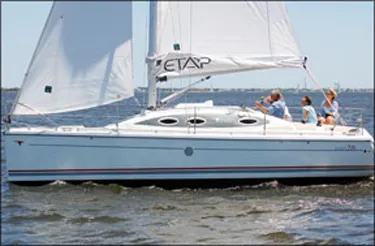
Photo by Billy Black
This is the only sailboat at most boat shows that will remain afloat even with a bucket-sized hole in the bottom. The design team, comprising Von Ahlen Yacht Design and EtapYachting, have come up with a ship-in-ship double-hull structure with enough closed-cell polyurethane foam between the skins to provide flotation-even if the hull is breached in multiple places. Etaps unsinkable attributes keep the boat afloat with most of its freeboard still showing! Not only does the foam have enough buoyancy to offset the weight of the ballast keel, diesel engine, and all other components, but the foam has been distributed so that a flooded boat would remain stable and be able to make way under reduced sail. This feature can be a significant safety factor to any sailor, but especially to those sailing in colder waters where flotsam or a labyrinth of off-lying reefs can really cause problems.
Design
The Etap 28s is an example of how modern European builders put International Standards Organization standards to the test, and the result is a better boat for consumers. Stability requirements for the ISO Offshore Category B are met using either the 5-foot-7-inch standard keel or a shoal draft 3-foot-6-inch tandem keel. According to the ISO STIX (stability index) method of calculation, the vanishing point of stability is 118 degrees, and the boats wide beam. carried well aft, and wedge-shaped footprint also add to its initial stability. The combined result is good sail-carrying ability and a boat that likes to be sailed flat rather than on high angles of heel.
In addition to setting specific stability requirements, ISO Offshore Category B standards demand commitment to structural benchmarks and the implementation of measures to prevent down-flooding. The result of this comprehensive focus on vessel integrity is a level of seaworthiness appropriate for the proposed usage of a vessel. As a Category B sailboat meant for coastal and short-hop offshore sailing, the Etap 28s is more than up for the task at hand.
With a displacement of 8,400 pounds, the Etap 28s is a stocky pocket cruiser. In addition to offering the fail-safe of positive buoyancy, she sports a spacious cabin for her size, along with a no-nonsense sail plan that makes it an easy boat to sail. However, theres no free lunch, and the extra beam, weight, and volume needed to add space for flotation results in a 28-footer with nearly 11 feet maximum beam. This adds to the skin drag and makes the addition of light-air sails a welcome option.
Etap gets high marks for design innovation, with “unsinkability” gaining plenty of attention. However, the boats Euro-styled blend of form and function has also hit the mark, and the user-friendly interior ranks high among potential buyers. The straight-forward tiller steering and simple sail plan also register as big pluses.
A couple of innovations miss their mark. The toerail is a good example. In essence, its a slightly elevated, tubular alloy structure that sheds water easily, provides quick attachment for lines and fenders, but also presents a hazard to toes unintentionally wedged under the rail. Similarly, the optional vertical tiller (a sort of hybrid cross between a wheel and a tiller) isn’t as user-friendly underway as it might seem on paper. Etaps big win is in the realm of double-hull construction and the safety linked to the boats inherent unsinkability.
On Deck
In most cases, the designers handle well the task of blending form and function. For example, the anchoring issues caused by a plumb bow are resolved with a nicely fabricated double bow roller that projects far enough to allow an anchor to clear the hull when launched or hoisted. The roller assembly also does double duty as a good asymmetric spinnaker tack point. Just aft of the stem is an anchor locker with a bottom thats mid height in freeboard rather than dropping all the way to the waterline. Its advantage is two-fold: It will fully drain when water enters regardless of tack, and, if flooded, the amount of lost buoyancy is small as compared to many other boats with cavernous anchor wells.
At the aft end of the fore triangle lies a self-tacking jib track that turns the furling headsail into a single-sheet self-tacking sail.
The deck-stepped spar is supported by a substantial compression post, and the wide beam creates shroud geometry that puts less load on the rig and rigging. On the negative side are the large, slick, sloping cabinhouse windows and smooth gelcoat that make up much of the angled coach roof. Its clear that stepping off the grippy nonskid of the side deck can be a slippery prospect.
Good hand rails along the coachroof and efficient line handlers lead halyards, reefing lines, and the crew back to the cockpit. Clearly marked rope clutches allow a single-hander to set sails, trim, and reef from one location. Coping with all the halyard and sheet tails does take some careful organization, but its easy enough to accomplish.
The Selden backstay-less Bergstrom rig is carefully engineered and well supported. As with all Selden installations, theres a completeness to the package that provides a consumer with more than just a mast, boom, and wire. The vang, electrical conduits, and even the Windex placement have been carefully fitted into the overall equation, and the results include user-friendliness and reliability.
The cockpit has a dual-purpose feel. Underway, its a utilitarian pit for sailors who know that a tiller-steered small boat affords the most fun of all. The open transom and big, wide stern with its pull-out boarding ladder add another dimension to cruising fun.
Accommodations
The Etaps wide beam carried aft gives lots of volume below, even after dedicating considerable space for the foam needed to insure reserve buoyancy. The big surprise, however, is the interior design styling. Not only has the company invested in innovative naval architecture, but it has certainly made good use of the available interior space.
Below is a contemporary interior-design theme thats anything but bound to traditional teak, buff colored bulkheads, and dark blue fabrics. Color, texture, and material are a modern blend of warm tones set off by stainless steel, birch trim, and a faux teak sole thats quite utilitarian. There are comfortable berths for weekend cruising, a minimal but functional galley, and separate enclosed head-all commingled in an open, spacious saloon.
Ventilation is adequate for temperate climates, with opening ports and a large foredeck hatch contributing to the air flow. Those cruising hotter climates will no doubt wish that the large, sloping, forward-facing fixed window in the coach was actually another opening hatch.
The engine is well supported on stringers that are integral with the inner hull. This structural approach is substantial and nullifies any movement between the inner hull skin and the outer hull. Good attention to detail can be seen in the wiring and plumbing runs throughout the boat, and the standards set by the ISO seem to be taken quite seriously. However, some of the systems incorporate fuses rather than circuit breakers, a trend we are seeing in more and more new boats, one that may be a step backward rather than forward.
The tanks are heavy-gauge roto-molded plastic held in place with well-shaped bunks and alloy straps. A high-grade aluminum tank, fitted with inspection/cleaning ports is preferable, but a well-made roto-molded tank wont rust and has no welds to fail. The lack of baffles and a small inspection plate in a plastic tank are acceptable if the tank is small, as it is in this case.
Aboard the Etap, the fills for water and diesel fuel are on opposite sides of the deck, but we did notice that the head discharge and intake through-hull fittings are located right next to each other. This may be an adequate approach when using the holding tank, but it is far from ideal when overboard discharge is allowed.
Performance
The 7/8ths Bergstrom alloy rig sports a classic large main and small jib configuration, and the 2-plus-2 batten, full-roach mainsail hoists and stows easily in its stack-pack sail cover. The upside of the no-backstay Bergstrom rig is that it allows the use of a very full-roach mainsail. This can significantly enhance reaching, but due to the angle of the spreader sweep, it doesn’t allow the main to be effectively sheeted for deep reaching and running. This is one reason why a cruising gennaker or asymmetric spinnaker is a good addition to the sail inventory.
In 12 to 15 knots of breeze, the Etap dances along, putting its 438 square feet of working sail area to maximum use. Under lighter conditions, the boats wide beam and moderate displacement take their toll, and the right remedy is the optional genoa hardware package and perhaps a nylon sail for sailing off the wind.
With the mast stepped fairly far forward, the boat balances nicely under main alone, and with an easy to handle self-tacking jib and slab reefing system thats controllable from the cockpit, a single-hander can quickly adapt to a wide range of wind and sea conditions.
Under power, the three-cylinder 19-horsepower Volvo D1 moves the boat at 6 knots and sips fuel in the process. The saildrive is smooth- running and the addition of a reliable diesel in a small cruiser is a big plus. The semi-balanced spade rudder does have a bit of prop-wash flutter, common among boats with props close to the rudder. This was a noticeable effect, but by no means a show-stopper.
Under sail, the rudder, supported by a self-aligning needle bearing, was a pleasure to handle. Extending the bearing up to the cockpit sole would be safer, but this would rule out a below-decks autopilot.
Bottom Line
When all is said and done, the Etap 28s weighs in as a worthy pocket cruiser ready for a daysail, weekend getaway, or a serious summer cruise. A young family or couple looking for a simple-to-sail, quick to get underway coastal cruiser should look closely at what the boat has to offer, keeping in mind that in the unlikely occurrence of a sailors worst nightmare, unsinkability is certainly worth its weight in closed-cell foam.








































Would like to chat to someone with knowledge of Etap 28i and mods that could be added.